`Back to the Future' for Hermanni Boerhaave or `A rational way to generate ultrasound scan charts for estimating the date of delivery'
The object of this paper is to discuss the routine use of ultrasound in estimating the date of delivery and to demonstrate an approach which has both sound epidemiological and statistical bases. CESDI (Confidential Enquiry into Still Births and Deaths in Infancy) criteria for determining gestation, based on menstrual dates and cycle length superseded by an ultrasound scan different by more than ten days, are difficult to apply.
The object of this paper is to discuss the routine use of ultrasound in estimating the date of delivery and to demonstrate an approach which has both sound epidemiological and statistical bases. CESDI (Confidential Enquiry into Still Births and Deaths in Infancy) criteria for determining gestation, based on menstrual dates and cycle length superseded by an ultrasound scan different by more than ten days, are difficult to apply. The pragmatic solution of using ultrasound measurements alone does not have universal support.. Data from 298 pregnant women provides a chart which has a single regression line.
Introduction
Aristotle, the father of scientific thinking, wrote that there was a certain definite term of gestation for all animals which varied from animal to animal according to its size and life expectancy. However in man, wrote the philosopher, "the human foetus is expelled both in the seventh and tenth months, and at any period of pregnancy between these; moreover, when the birth takes place in the eighth month it is possible for the infant to live." (Harvey 1647) William Harvey, writing in the early 17th century, thought that women were most prone to conceive either just before or just after the menstrual flux. It was however Harmanni Boerhaave (1744) who formulated a way of calculating the expected date of delivery, and the rule was later given publicity by Franz Naegele (Naegele 1812) to whom it is named after today.
The guidance provided by CESDI for completion of their rapid report form states that the calculations for gestation should be based on the first day of the last period, also advise that the length of a regular menstrual cycle be taken into account. The CESDI guide then goes on to recommend that calculations should be superseded by a scan measurement before 20 weeks if it differs by more than ten days from the menstrual estimate, still taking into account the length of the cycle. Such advice, while sound in theory, is difficult to apply accurately in practice. It is common in clinical practice and also in clinical research (Nwosu et al 1994) to state that the gestation of a pregnancy was confirmed by ultrasound scan although the precisely acceptable discrepancy may vary. Many obstetricians are recommending ultrasound measurements using properly prepared charts for the dating of all pregnancies.( Leeson and Aziz 1997, Geirsson 1992) It is certainly a pragmatic solution to the difficulty in applying the CESDI criteria referred to above, however other obstetricians feel that it is statistically illogical since most commonly used ultrasound charts are based on the menstrual data of a selected population. (Campbell 1969, Chitty et al 1994, Snijders & Nicolaides 1994) Since these charts are prepared from a population of women who have certain knowledge of their dates and regular cycles, the charts may not apply appropriately to women who do not know their dates. (Hall 1985)
Materials and methods
Menstrual, ultrasound and delivery details were entered into a computer data base by midwives and ultrasonographers as part of routine maternity care in a district general hospital. All ultrasonographers were qualified with the Diploma in Medical Ultrasound. Only one measurement per patient is included, usually that taken at the routine anomaly scan between 16 and 20 weeks. Biparietal diameter mesurements (BPD) were made in the plane described by Campbell & Thomas (1977) from the proximal edge of the proximal echo to the proximal edge of the deep border (outer - inner) of the fetal skull echo. 298 patients were eligible from the database. The inclusion critera in the study population were as follows:
1. A normal singleton pregnancy leading to a live healthy baby
2. The spontaneous onset of labour.
All babies were routinely examined by a paediatrician. Any babies who required admission to the special care baby unit were excluded. Exclusion criteria included admission for respiratory problems, low apgar score, prematurity and hypothermia. There was one stillbirth. Women who were uncertain of their LMP, had irregular cycles or had been on the oral contraceptive pill were not excluded.
Results
Regression analysis was carried out on 298 women who had a BPD between 37 mm and 49 mm 3 with adequate numbers in each measurement. Measurements were rounded up to whole numbers. Regression analysis of the biparietal diameter of the fetus and the mean interval in days between the scan and the onset of spontaneous labour was carried out on Microsoft Excel ® Ver. 5.0 (Microsoft Corp.) using the "least squares" method..( Fig 1 ) An extremely good fit is obtained with an R2 value of 0.99. The Y axis has been converted into conventional "weeks gestation" by subtracting the actual interval in days between the scan and delivery from 280 and dividing by 7. A linear fit between 14 and 22 weeks has also been shown by Mul et al (1996) to provide an equally good fit with that of a quadratic relation. Mean birth weights and the age of women is shown in Table 1. Six percent of babies were delivered by Caesarean Section after the spontaneous onset of labour and this intervention led to the delivery of a healthy baby in all those included in the study. A scatter diagram (Figure 2) shows the range of intervals, the upper green line corresponds to 37 weeks gestation and the lower yellow line to 42 weeks.
Click here for Figure 1
Click here for Figure 2
Figure 2 Regression analysis showing line fit plot. The number of days between scan and delivery has been converted to conventional gestation by subtracting from 280. The lower and upper dotted lines represent delivery at 42 and 37 weeks respectively..
Click here for Figure 3 Figure 3 A similar chart was prepared using crown rump length measurements available from 79 of the women in the first trimester is shown in figure 4. With larger numbers such a chart might provide greater accuracy. The chart corresponds well with other published data. (Daya 1993)
Click here for Figure 4
Click here for Figure 5
Click here for Table 1
Discussion
The value of accurate pregnancy dating is undisputed. It seems inappropriate for clinicians to use one method to estimate gestation and CESDI (NAB Secretariat 1997) to recommend another. Unlike conventional ultrasound charts of fetal size for dating, this new chart has no upper and lower centiles since the constant is the measurement of the BPD. The chart is only for estimating the date of delivery. There is no "normal" range in the BPD measurements, virtually all the variability occurs around the interval to delivery which corresponds with the traditional range of 37 to 40 weeks gestation. The graph should be used to provide an estimated date of delivery as follows; with a BPD of 42mm the baby can be expected to deliver on average 21 weeks + 5 days later. The chart shows the expected range, corresponding to 42 weeks (lower line) and 37 weeks (upper line). Delivery outside this normal range is more likely to lead to an unhealthy baby. This published chart is only valid for BPD’s between 37 and 49 mm ( about 16 to 20 weeks) and is intended primarily to demonstrate the principle. The only uncertainty in the method is the small error associated with the ultrasound measurement since both the date of the scan and the date of delivery are precise. The scattergram shows a good fit between 37 and 42 weeks. Just as Boerhaave was not actually measuring the length of pregnancy, and the word "gestation" is used to describe the measurement of time from the last menstrual period to reflect this, so also there is no pretence that this method is determining fetal age. The graphs are converted into "gestational age" to fit into current convention. This approach could satisfy both pragmatists and purists for determining the expected date of delivery from ultrasound measurements.
There are several problems in the construction of conventional dating charts. Firstly there is uncertainty in both axes and this requires complex statistical analysis not usually carried out in published charts. (British Medical Ultrasound Society 1990) In our chart there is uncertainty only in one axis. Secondly, the study population for normal charts must be "certain" of their last menstrual period, or the data can be derived from artificial reproductive techniques. Not only does this limit the numbers which the study can recruit but may also introduce bias which prevents the charts being appropriate for women who are unsure of their dates; the very population for which the charts are most needed. One commonly used chart (Chitty et al 1994) used prior ultrasound charts to exclude those women who were outwith 10 days of the normal range. This is a pragmatic solution to eliminating women who are likely to be well out in their menstrual estimation of gestation. It assumes however the validity of the original charts. Snidjers and Nicolaides (1994) used a population which may have been biased by referral criteria to a regional centre. IVF pregnancies have also been used to generate and validate crown rump length (CRL) and BPD charts. (Daya 1993, Mul et al 1996) While there is no evidence that singleton IVF pregnancies are different from normal conceptions, it is perhaps unwise to make this assumption.
The best BPD charts have been shown to predict gestation with a 95% confidence of 8.4 days.(Mul et al 1996) When this is added to the uncertainty of the onset of normal labour between 37 and 42 weeks, the range of uncertainty becomes about seven and a half weeks. The 95% confidence interval for the date of delivery using our chart is five weeks.
This is a small study which is not intended to provide definitive charts either for general use or even for our own population. The measurements however correspond very closely with those of Altman and Chitty (1997) (Figure 3) and are therefore likely to be valid. This sort of analysis has never been attempted before. The approach mimics, in modern terms, the method originally formulated by Boerhaave. By adopting this approach we do not need to concern ourselves about the length of the cycle nor the certainty of the dates. Provided the fetus can be assessed as normal using other criteria, this chart can be used to provide the best estimate of the date of delivery (EDD). This chart is based on women with both certain and uncertain dates, and can therefore be applied to women with both certain and uncertain dates. With limited resources it is not always possible to obtain a scan early enough in pregnancy to provide a reliable crown rump length and reliance on a second trimester BPD may be necessary.
If Boerhaave had had an ultrasound scanner his paper might have read something like "It is proved by numerous observations that 99 out of 100 births occur 22 weeks ( at 18 weeks gestation) after the biparietal diameter of the fetus is 40mm." (Fig 1)
Charts prepared in this way have a small bias since post-mature pregnancies which are induced are not included. The direction of the bias is known and the extent can be readily estimated. Assuming that no healthy pregnancy can persist after 43 weeks and a policy of induction at 42 weeks leading to a rate of 10%, an estimated 0.5 days should be added to the mean gestations (0.35=0.1 x 7/2).
Customised dating charts for a whole range of characteristics of a local population such as height, weight, fetal sex and ethnic origin could improve antenatal care. This approach to ultrasound dating should lead to larger numbers of women being eligible for a database and allow easier development of customised charts to take account of ethnic differences, differences in maternal size and fetal sex. Once each pregnancy is dated accurately and consistently, there is the potential for the generation of improved charts of fetal size and the better detection of the intra-uterine growth retarded fetus.
Acknowledgements
I am grateful to the ultrasonographers and the midwives for entering the data.
Figure 1
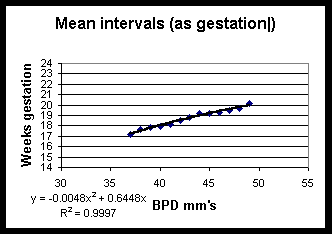
Figure 2
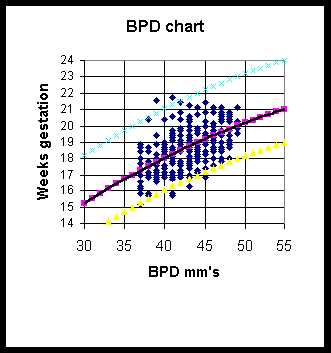
Figure 3
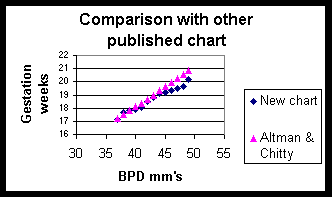
Figure 4
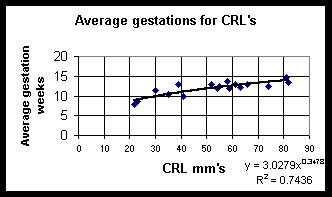
Figure 5
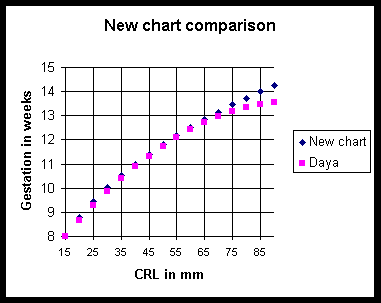
Table 1
References:
References
1. Altman D G & Chitty L S New charts for ultrasound dating of pregnancy (1997) Ultrasound Obstet Gynaecol 10:174-191
2. British Medical Ultrasound Society Fetal Measurements Working Party. (1990) Clinical applications of ultrasonic fetal measurements. British Institute of Radiology.London
3. Boerhaave H.(1744) Praelectiones Academicae in Propias Institutiones Rei Medicae. Von Haller A, ed. Göttingen:Vandehoeck. 5 (part 2):437
4. Campbell S (1969) The prediciton of fetal maturity by ultrasonic measurement of the biparietal diameter. J Obstet Gynaecol Brit Cwlth, 76:603-609
5. Campbell S & Thomas A (1977) Ultrasound measurements of the fetal head to abdominal circumference ratio in the assessment of growth retardation. Br J Obstet Gynaecol 84: 165-174
6. CESDI Guidance for al questions. 1997 Rapid Report Form NAB Secretariat Confidential Enquiry into Stillbirths and Deaths in Infancy
7. Chitty L S Altman D G Henderson A et al (1994) Charts of fetal size: 2 Head measurements Br J Obstet Gynaecol 101:35-43
8. Daya S. Accuracy of gestational age estimation by means of fetal crown-rump length measurement.(1993) Am J Obstet Gynecol;168:903-8
9. Geirsson R T. (1991) Ultrasound instead of last menstrual period as the basis of gestational age assignment. Ultrasond Obstet Gynaecol. 1:212-219
10. Hall M H and Carr-Hill R A (1985) The significance of uncertain gestation for obstetric outcome. Br J Obstet Gynaecol, 92 452-460
11. Harvey, W. (1847) The works of William Harvey M.D. Translated from the Latin by R Willis. Sydenham Society, London, p524
12. Leeson S and Aziz N (1997) Customised fetal growth assessment. Br J Obstet Gynaecol 104:648-651
13. Mull T, Mongelli M and Gordosi J.(1996) A comparative analysis of second-trimester ultrasound dating formulae in pregnancies conceived with artificial reproductive techniques. Ultrasound Obstet Gynaecol 8:397-402
14. Naegele F C.(1812) Erfahrungen und Abhandlungen aus dem Gebiethe der Krankheiten des Weiblichen Geschlechtes. Nebst Grundzügen einer Methodenlehre der Geburtshülfe. Mannheim:Loeffler
15. Nwosu E C, Welch C R, and Walkinshaw S A (1994) Measurement of amniotic fluid volume using maximum pool depth. Contemp Rev Obstet Gynaecol; 6: 25-28
16. Snijders R J M, and Nicolaides K H.(1994) Fetal biometry at 14 - 40 weeks’ gestation. Ultrasound Obstet Gynecol;4:34-48
Recap on reproductive rights with David Hackney, MD, MS
December 20th 2022In this episode of Pap Talk, we spoke with David Hackney, MD, MS, maternal-fetal medicine physician at Case Western Reserve University and chair of ACOG's Ohio chapter for a full recap of where restrictions on reproductive rights have been and where they're going.
Listen
In this episode of Pap Talk, Gloria Bachmann, MD, MSc, breaks down what it means to be a health care provider for incarcerated individuals, and explores the specific challenges women and their providers face during and after incarceration. Joined by sexual health expert Michael Krychman, MD, Bachmann also discusses trauma-informed care and how providers can get informed.
Listen



















